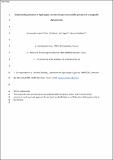Files in this item
Understanding imitation in Papio papio : the role of experience and the presence of a conspecific demonstrator
Item metadata
| dc.contributor.author | Formaux, Anthony | |
| dc.contributor.author | O'Sullivan, Eoin | |
| dc.contributor.author | Fagot, Joel | |
| dc.contributor.author | Claidière, Nicolas | |
| dc.date.accessioned | 2022-03-17T15:30:01Z | |
| dc.date.available | 2022-03-17T15:30:01Z | |
| dc.date.issued | 2022-03-16 | |
| dc.identifier | 277760639 | |
| dc.identifier | 2c0d6099-6c79-468e-bb60-25b5722e344b | |
| dc.identifier | 85126666731 | |
| dc.identifier | 000773510900006 | |
| dc.identifier.citation | Formaux , A , O'Sullivan , E , Fagot , J & Claidière , N 2022 , ' Understanding imitation in Papio papio : the role of experience and the presence of a conspecific demonstrator ' , Cognitive Science , vol. 46 , no. 3 , e13117 . https://doi.org/10.1111/cogs.13117 | en |
| dc.identifier.issn | 0364-0213 | |
| dc.identifier.other | ORCID: /0000-0001-9380-1648/work/110131893 | |
| dc.identifier.uri | https://hdl.handle.net/10023/25061 | |
| dc.description.abstract | What factors affect imitation performance? Varying theories of imitation stress the role of experience, but few studies have explicitly tested its role in imitative learning in non-human primates. We tested several predictions regarding the role of experience, conspecific presence, and action compatibility using a stimulus-response compatibility protocol. Nineteen baboons separated into two experimental groups learned to respond by targeting on a touch screen the same stimulus as their neighbour (Compatible) or the opposite stimulus (Incompatible). They first performed the task with a conspecific demonstrator (Social phase) and then a computer demonstrator (Ghost phase). After reaching a predetermined success threshold, they were then tested in an opposite compatibility condition (i.e., Reversal learning conditions). Seven baboons performed at least two reversals during the social phase, and we found no significant difference between the compatible and incompatible conditions, although we noticed slightly faster RTs in the compatible condition that disappeared after the first reversal. During the ghost phase, monkeys showed difficulties in learning the incompatible condition, and the compatible condition RTs tended to be slower than during the social phase. Together, these results suggest that 1) there is no strong movement compatibility effect in our task, and that 2) the presence of a demonstrator plays a role in eliciting correct responses but is not essential, as has been previously shown in human studies. | |
| dc.format.extent | 21154833 | |
| dc.language.iso | eng | |
| dc.relation.ispartof | Cognitive Science | en |
| dc.subject | Automatic imitation | en |
| dc.subject | Social learning | en |
| dc.subject | Stimulus-response compatibility | en |
| dc.subject | Mirror neuron | en |
| dc.subject | Guinea baboon | en |
| dc.subject | Ghost demonstrator | en |
| dc.subject | BF Psychology | en |
| dc.subject | RC0321 Neuroscience. Biological psychiatry. Neuropsychiatry | en |
| dc.subject | DAS | en |
| dc.subject | AC | en |
| dc.subject.lcc | BF | en |
| dc.subject.lcc | RC0321 | en |
| dc.title | Understanding imitation in Papio papio : the role of experience and the presence of a conspecific demonstrator | en |
| dc.type | Journal article | en |
| dc.contributor.institution | University of St Andrews. School of Psychology and Neuroscience | en |
| dc.identifier.doi | 10.1111/cogs.13117 | |
| dc.description.status | Peer reviewed | en |
This item appears in the following Collection(s)
Items in the St Andrews Research Repository are protected by copyright, with all rights reserved, unless otherwise indicated.

